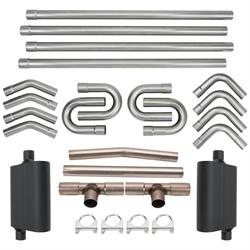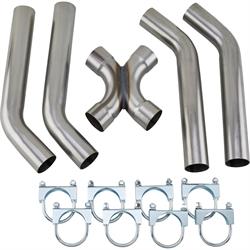X-Pipe VS H-Pipe VS Y-Pipe | Types of Exhaust Pipe Systems
Different Types of Exhaust Pipes | Performance Midpipe Exhaust Explained
When it comes to performance exhaust, we often focus on the headers vs manifolds that actually bolt to the cylinder head. But in most cases, the exhaust hasn’t left the building until it passes through the rest of the exhaust system. The difference in exhaust systems from the headers to the tailpipe can have a big impact on sound and performance, and the “mid-pipe” in particular is a very important component. What is a mid-pipe? We’re talking about the section of exhaust between the manifolds or headers and the mufflers. There are several different mid-pipe designs, and we’re going to take a look at some of the advantages and disadvantages of the various types of exhaust pipes.
X-Pipe vs H-Pipe These are the designs that we see most commonly used on rear-wheel-drive V8 performance cars. For decades, the prevailing design on these cars used what we’ll call “straight pipes.” No, we’re not talking about the straight pipes that forego the muffler altogether, but instead a mid-pipe design that used two pipes from the collectors to the mufflers with no crossover in between them. More recently, it’s become popular to run a mid-pipe design that merges the two pipes together. The two most popular designs are an “H-pipe” and an “X-pipe,” and each have their own distinct characteristics. Common to both is the general benefit that merging the exhaust pulses from each bank of the engine can create a noticeable performance benefit as well as changing the exhaust note significantly.
The general idea of any crossover pipe is to balance out the high-pressure pulses in the exhaust tubes. The engine’s firing order creates high- and low-pressure pulses that are unevenly distributed when they hit the header collector and pass through the exhaust. A crossover pipe or balance tube is designed to do just that, balance those pulses for less backpressure and better exhaust scavenging.
An H-pipe exhaust is generally the most straightforward way to do this. H-pipes simply add a crossover tube between the two exhaust pipes. Because that tube can be just about any length and bent as necessary, H-pipes are very easy to package under the car.
As for performance and sound, H-pipes offer the performance boost that comes from the addition of a balance tube, but tend to provide more of a boost at lower rpm when compared to an X-pipe. H-pipe vs X-pipe exhaust sound tends to be more mellow, with a deep growl that’s well suited for a classic muscle car or hot rod.
An X-pipe design goes one step beyond the H-pipe by creating a linear crossover point for the two pipes that is shaped like an X. This design tends to do a better job of promoting exhaust scavenging, so an X-pipe exhaust kit will generally have a slight performance edge over an H-pipe, especially at higher RPM. The sound of an X-pipe tends to be a bit higher-pitched and raspy, lending a slightly more exotic note when compared to an H-pipe.
Y-Pipe vs H-pipe vs X-Pipe Another configuration that merges both banks is the Y-pipe. These are typically found on factory applications or under cars where space is limited. Y-pipes often come up in the conversation about dual exhaust vs single and what is an intermediate pipe on exhaust. While the same principle applies here in that there is some benefit to merging the banks, a Y-pipe vs H-pipe or X-pipe generally won’t flow as well. Think of two on-ramps merging onto one busy freeway, there’s bound to be some congestion and reduced speed.
Keep in mind that the best mid-pipe exhaust system for your car needs to pair the preferred crossover design with the proper diameter exhaust piping and the best exhaust parts for your application. Check out our exhaust pipe size chart to find the best setup for your car.
What is Exhaust Scavenging
Scavenging is an increase in an engine’s volumetric efficiency caused by the fast-moving exhaust gases leaving the chamber pulling in air and fuel through the intake. As the exhaust gases enter the header, there is a high-pressure surge, followed by a low-pressure area. When the proper header and exhaust design is paired to the engine, that low pressure area creates a vacuum that actually pulls the exhaust gases out of the chamber while also pulling fresh air and fuel in through the intake valve during the overlap period where both the intake and exhaust valves are open. Header design and equal exhaust length matters to exhaust scavenging, but so does the rest of the exhaust system.
We recently saw this effect on the dyno with a mild small block Chevy. With no changes to carburetor jetting, the air/fuel mixture changed when restrictive exhaust manifolds were replaced with long tube headers. The improved scavenging of the headers was pulling more air and fuel through the carb and into the chamber.
Difference in Exhaust Systems What does a mid-pipe do to help exhaust scavenging? When served up visually, it’s easy to see how an X-pipe promotes scavenging by creating a linear path for the exhaust pulses to merge. An H-pipe, on the other hand, requires a 90-degree turn, which allows volume for the gases to equalize, but doesn’t do as good of a job at creating the high-speed flow that promotes scavenging and power gains at high RPM.
Best Exhaust System
Like nearly all modifications you can make to your car, there are pros and cons to every decision. Here’s a quick look at some of the benefits and drawbacks of each type of mid-pipe system.
Generally speaking, when paired with the best performance muffler design an X-pipe will create a slight performance advantage over other designs, but they can be hard to package. Anything to balance out the uneven pulses through the exhaust system will give your car a little boost, and who doesn’t love cheap horsepower?



